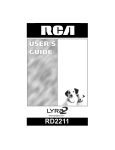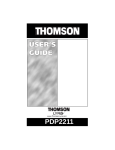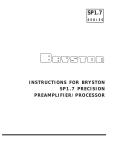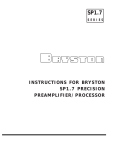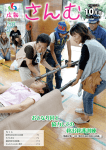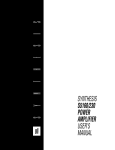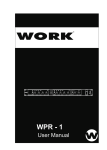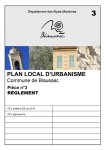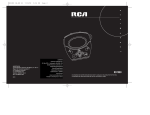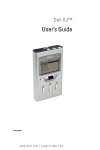Download RCA Lyra RD2204 64 MB MP3 Player
Transcript
www.LyraZone.com RD2201/2202/2204 Important Safety Information Be sure to read all the safety information before you begin to use this product. IMPORTANT NOTE: To reduce the risk of fire or shock hazard, do not expose this player to rain or moisture. This symbol indicates “dangerous voltage” inside the product that presents a risk of electric shock or personal injury. CAUTION RISKOFELECTRICSHOCK DO NOT OPEN ATTENTION RISQUEDECHOCELECTRIQUE NEPASOUVRIR C O A U N T IAUC TION This symbol indicates important instructions accompanying the product. TO REDUCE THE RISK OF ELECTRIC SHOCK, DO NOT REMOVE THE COVER (OR BACK). NO USER-SERVICEABLE PARTS ARE INSIDE. REFER SERVICING TO QUALIFIED SERVICE PERSONNEL. FEDERAL COMMUNICATIONS COMMISSION INFORMATION This device complies with Part 15 of the FCC Rules. Operation is subject to the following two conditions: (1) This device may not cause harmful interference, and (2) This device must accept any interference received, including interference that may cause undesired operation. Note: This equipment has been tested and found to comply with the limits for a Class B digital device, pursuant to part 15 of the FCC rules. These limits are designed to provide reasonable protection against harmful interference in a residential installation. This equipment generates, uses and can radiate radio frequency energy and, if not installed and used in accordance with the instructions, may cause harmful interference to radio communications. However, there is no guarantee that interference will not occur in a particular installation. If this equipment does cause harmful interference to radio or television reception, which can be determined by turning the equipment off or on, the user is encouraged to try to correct the interference by one or more of the following measures: – Reorient or relocate the receiving antenna. – Increase the separation between the equipment and the receiver. – Connect the equipment into an outlet on a circuit different from that to which the receiver is connected. – Consult the dealer or an experienced Radio/TV technician for help. This Class B digital apparatus complies with Canadian ICES-003. SERVICE This product should be serviced only by those specially trained in appropriate servicing techniques. For instructions on how to obtain service, refer to the warranty in this guide. Attach your sales receipt for future reference, or write down the date you purchased or received this product as a gift. This information will be valuable if service should be required during the warranty period. Model No: ___________________________________________________________________ Serial No: ___________________________________________________________________ Purchase Date: _______________________________________________________________ Purchased From: ______________________________________________________________ 2 Introduction Your Lyra personal digital player is designed to give you hours of listening pleasure. To get the most out of your new purchase, we suggest that you take a few minutes right now to read through this instruction manual. If you have any questions or problems, consult the Troubleshooting Guide or log onto www.lyrazone.com for help and recent updates. Table of Contents Important Information ...... 2 Player Features ................. 18 System Requirements ...................... 2 Controls ......................................... 18 Warning ........................................... 2 Playing a CompactFlash Card .......................................... 20 Caution While Driving .................... 2 Getting Started .................... 3 Unpack the Player and Accessories ................................. 3 Connect the External Drive ............. 4 Install the RealJukebox* Software .. 5 Set Basic Preferences ...................... 7 Learn the RealJukebox Basic Controls ............................ 9 Saving CD Tracks to Play on Your PC or in Your Lyra™ Player ....... 9 Download Music from the Internet ................................. 11 Organize the Library ...................... 12 Transfer the Audio Files to the CompactFlash** Card .............. 13 Playback Features .......................... Pause Feature ........................... Auto Resume Feature ............... Skip and Search Features ......... Scroll Feature ........................... 22 22 22 23 23 Mode Menu ................................... 24 Repeat and Shuffle Features .................................. 24 Program Feature ....................... 25 DSP (Digital Signal Processor) Menu ......................................... 26 DSP Modes ............................... 26 Equalizer Feature ..................... 27 Included Accessories ......... 28 CompactFlash Memory Cards ......................................... 28 Removable Belt Clip ..................... 28 Insert the Batteries Into the Player ........................................ 15 Models RD2202 and RD2204 (Car Kit) ................................... 29 Insert the CompactFlash Card In the Player ..................... 16 Optional Accessories ......... 30 Attach the Headphones to the Player ........................................ 16 Play the CompactFlash Card .......................................... 17 Specifications ..................... 32 Troubleshooting Guide ..... 33 Limited Warranty ............. 34 Index .................................. 36 *G2, RealJukebox, and RealNetworks are trademarks of RealNetworks, Inc. **CompactFlash is a trademark of SanDisk Corporation 1 Important Information The Lyra works with your computer to let you play your favorite music from files recorded on removable CompactFlash* cards. The player plays files encoded with the popular MP3 and RealNetworks** G2 audio formats and may allow for future upgrades of some alternative audio compression formats. Because the player has no moving parts, the audio can be played back virtually anywhere without skipping. You can download MP3 and G2 encoded music files from several internet sites to your computer hard drive or record your favorite CD using the software supplied. Some of the internet sites you may want to explore are: • www.real.com • www.mpeg.org • www.mp3.com Computer System Requirements Minimum Optimum • Pentium 166 MHz or faster • Pentium II 300MHz • 32MB RAM • 64MB RAM • Windows 95/98/NT • Windows 95/98/NT • 45 MB free hard disk space plus 1 MB for every minute of CD quality music you store on your hard drive. • 45 MB free hard disk space plus 1 MB for every minute of CD quality music you store on your hard drive. • CD-ROM Drive • CD-ROM Drive • 256 Color, Mouse, PS/2 Keyboard • 256 Color, Mouse, PS/2 Keyboard • Parallel Port • Parallel Port • Full Duplex Sound Card • Full Duplex Sound Card Warning Use of this product is for your personal use only. Copying CDs or downloading music files for sale or other business purposes is a violation of copyright law. It is also a violation of copyright law to download files without permission of the copyright owner. Caution While Driving Use of headphones while operating an automobile or moving vehicle is not recommended and is unlawful in some states and areas. Be careful and attentive on the road. Stop operation of the unit if you find it disruptive or distracting while driving. Caution Exposure to direct sunlight or extreme heat (such as inside a parked car) may cause damage or malfunction. *CompactFlash is a trademark of SanDisk Corporation **G2, RealJukebox, and RealNetworks are trademarks of RealNetworks, Inc. 2 Getting Started 1. Unpack the player and accessories. When you unpack your new player, be sure you have removed all the accessories and information papers. The items shown below are packed with your player. DSP + LIGHT PLAY Com MODE STOP • OFF SKIP/REV. SKIP/FWD. + Multi-Media Player with Removable Belt Clip - Models RD2201 and RD2204 Only: “AA” Alkaline Batteries . RealJukebox Software CompactFlash External Drive with Attached Cables pact Flas h CompactFlash Removable Memory Card Models RD2202 and RD2204 Only: Car Conversion Kit Headphones 3 Getting Started 2. Connect the CompactFlash* external drive. The external drive allows you to transfer the MP3 or G2 files to the CompactFlash card. Attach it to the parallel port of your computer. The external drive cables have pass-through connectors so you can attach the CompactFlash drive at the same time your printer and keyboard are attached. Connector Cable A. Attach to parallel port of computer. and A. Attach to keyboard connector of computer. (Note: If keyboard connector is not available, PS2 mouse port may be used.) D. yellow LED B. Attach Keyboard Cable C. Attach Printer Cable Note: Actual items may differ in appearance from those shown. the connector cable. Attach the parallel port and keyboard connector cables to your computer. A. Follow the computer shutdown procedure, and turn off your printer and any parallel port device(s). Remove any printer cable (or other device cable) attached to your parallel port. Attach the external drive cables to the parallel port and keyboard connector of your computer. Notes: Most printers will not print any differently connected to the pass-through. In some cases, printing may be delayed or aborted (depending on the system) if printing takes place at the same time you are using the drive. B. Remove the keyboard cable from the computer, and attach it to the pass-through on the keyboard connector cable. Most other devices are fully compatible when connected to the pass-through. In a few cases, some may lose some functionality. Note: If you have an AT keyboard, you may need an adapter. C. Attach the printer (or other device) to the pass-through on Consult your computer or device’s owner manual for troubleshooting. D. Turn on your computer. *CompactFlash is a trademark of SanDisk Corporation 4 Getting Started 3. Install the RealJukebox* software. Install this software on your computer. You can use it to compress audio files from CDs to MP3 or G2 (Real Network) format or download already compressed files from the internet, and then transfer the files to the CompactFlash card to play them on your player. It also operates as a Virtual Audio Player on your PC. Note: Updates are available at http://www.Lyrazone.com/downloads.htm/. A. After you attach the external drive as described on the previous page, turn on and boot your computer. B. Insert the RealJukebox CD into your CD ROM drive. The setup program screen appears. Notes: If the setup screen does not appear, double click My Computer, double click your CD-ROM drive icon, and double click setup.exe. , Run, You can also click then type D:\setup.exe (where D is the letter of your CD-ROM drive). C. Setup consists of two parts. 1. Install Connect-iT. (CompactFlash drivers) to activate the external drive. Click the Install Compact Flash button, and follow the on-screen instructions. Click Yes to restart your computer when prompted. Notes: The icon for this drive will only appear when the CompactFlash card is inserted. To access this , utility click Programs, CF External Drive, and Connect-iT. 2. After you restart your computer, the main setup screen will appear again. Click Install RealJukebox to install the RealJukebox and G2 player software. *G2, RealJukebox, and RealNetworks are trademarks of RealNetworks, Inc. 5 Getting Started 3. Install the RealJukebox™ software. (continued) Note: If the screen does not appear, see Step B Notes. Click Accept or Decline after you read the license agreement. 3. Complete the Electronic Registration Card. Enter your country and zip code, and click next to proceed. 4. Click Yes when the screen asks if you plan to use a portable music player, and click next when Lyra appears. 5. Configuration Options screens. These screens will list the most common and default configuration settings. You can change the settings or click Finish. Note: You must Accept to continue. When the next screen appears, enter your email address. We suggest you click Finish and not change any of the settings at this time. Note: (if you don’t have an email address, enter [email protected]). You must enter an email address to proceed. If necessary, minimize the RealJukebox window and click Exit on the installation window. Note: It is possible that the installation menu will display “Not-installed”. It is not necessary to install the program again, just click Exit and close the window. 6. Verify the correct destination path for the program files. Enter your software’s serial number (12-digit number located on the back of the RealJukebox CD jacket). 6 If necessary, close the main setup screen. Note: You can access the Configuration Wizard from the Options menu at any time later when you are more familiar with the program. Getting Started 4. Set basic preferences. Detailed information, tutorials, and troubleshooting are available through the Help menu and the RealJukebox Internet site (accessed from the Help and Sites menus). B. Click Recording Options to display the Recording Options menu. Note: We recommend you familiarize yourself with the RealJukebox New User’s Guide and complete the Online Tutorial before using and recording files. We also recommend that you log onto the internet while using RealJukebox to take advantage of all the features. We feel the Recording Method and a few of the Encoding Options Preferences need to be discussed before you start using the RealJukebox software. A. Display the Preferences menu by choosing Preferences under the Options menu. 1. Select a recording method. A. Check Digital and Use Error Correction for the best results. Error checking and correction will be performed while you are recording. Note: Choosing Error Correction will slow down your recording speed. B. Check Analog if your CD-ROM drive does not support digital audio extraction. (continued on next page) 7 Getting Started 4. Set basic preferences. (continued) C. With the Preferences menu displayed, click Encoding Options to display the Encoding Options menu. C. Wave Audio is unencoded music that is not compressed. This format has the best quality sound but requires the largest file size, as much as 650MB per CD. Wave Audio files are much larger than RealAudio and MP3 Audio files. 2. Secure Files Setting A. Secure Files On Files recorded with security on can only be played on the PC on which they were recorded. 1. Select a recording Format and Quality Level. A. RealAudio is RealNetworks’ audio format. This format saves your music as RealAudio (.rmx) secure or RealAudio unsecured (.rmj) files. Compression levels available are (96, 64, and 44 Stereo, and 32 Kbps Mono). 96kbps Stereo has the best quality sound, but uses the most disk space. B. MP3 Audio is MPEG layer 3 Audio available at four compression levels (128, 96, 64, and 56Kb Stereo). 128Kb has the best quality sound, but uses the most disk space. 8 Notes: If you record with the security feature on, make sure you perform a security key back up (Backup Security Key feature located under Options menu). B. Secure Files Off Most people choose to turn the Secure Files feature off. Notes: In the future, some music may require the security feature turned on to record to your computer. Turn this feature off if you own two computers and want to exchange files between them. Getting Started 5. Learn the RealJukebox basic controls. Listed below are the basic functions of the main controls for the program. Eject Continuous Play Stop Next Button Play Button Button Button Button Pause Get CD Info Record Shuffle Play Previous Button Progress Bar (i ) Button Button Button Button Mode Selection Volume Control Program Information Display Area 6. Saving CD tracks to play on your PC or in your Lyra™ player. 1. Insert a CD into your CD ROM drive. If you have auto play/record enabled, the CD will automatically begin playing and recording. Choose Preferences in the Options menu, and set the options for your personal preference. Note: If you do not want the CD to automatically start playing or recording, you can change the settings. (continued on next page) 9 Getting Started 6. Saving CD tracks to play on your PC or in your Lyra™ player. (continued) RealJukebox connects to the internet to retrieve information about the CD in the CD ROM. Notes: If the browser does not launch automatically, open it manually and click the “ i ” button to connect to the internet. Make sure the Get CD info from the Internet is selected in the Internet Settings Preferences. Choose Internet Setting from Preferences in the Options menu. If you are on a LAN system and the titling feature does not work, contact your administrator. The information from the internet appears on your screen. If the information cannot be retrieved from the internet, enter it manually. Important Note: If the information is not entered, titling and sorting information will not be available in the library. 10 Getting Started 6. Saving CD tracks to play on your PC or in your Lyra™ player. (continued) 2. Select the tracks you want to play or record. • To start or stop playback, click play. 3. After recording is complete, the songs will be stored in the Music Library. • To start or stop recording, click record. • To pause playback, press pause. • To stop playback and recording, press stop. 7. Download music from the internet. A. Click the get music icon to have RealJukebox connect you to the internet. B. Download the music you select to your PC, and add it to your library and playlists. Note: You can also download files using your regular browser. Just be sure to import (and/or move) them into RealJukebox. 11 Getting Started 8. Organize the library. A. The Master Library can be grouped by Genre, Artist, Album, or all three. Choose Music Library from Preferences in the Options menu. B. Select the groupings, that you would like to use for your music (any combination of Artist, Album, or Genre). C. Click the music library icon and Double click Master Library to view the groups of songs. To play a song, double click it or highlight it, and press play. Create a Playlist for playing or recording. 12 1. Click the New Playlist button on the bottom of the screen. 2. Name your new playlist. 3. Select the music you want to record in the playlist. Drag and drop the desired songs to the Playlist icon. Note: Click to select a song, Shift and click to select groups of songs, or Ctrl and click to select multiple songs. Getting Started 9. Transfer the audio files to the CompactFlash Card. Use RealJukebox to transfer music files to the removable storage card so you can take the music with you anywhere. ImportantNote Removing the card before the data is completely written may cause loss of the entire contents of the card and damage the card. A. Make sure the external drive is installed properly and the CompactFlash card is inserted. Note: If you remove and reinsert the card, press F5 to refresh the Master Library’s directory. Make sure your player is listed in the Master Library under Portable Music players. Note: Actual items may differ in appearance from those shown. Yellow LED Insert card top first with front (dogs) facing up. B. Double click the Lyra icon to display the Flash Card icon. C. Double click the Flash Card icon to see what is recorded on the flash card. D. Select the music you want to record on the card. Drag and drop the desired songs to the Flash Card icon. Note: Click to select a song, Shift and click to select groups of songs, or Ctrl and click to select multiple songs. 13 Getting Started 9. Transfer the audio files to the CompactFlash Card. (continued) E. After you have selected (dragged and dropped) all of the music you want to record on the flash card, double click the Flash Card icon. File size and availability are listed in the status and window displays Notes: The card operates like a floppy drive. The same drag and drop or copy methods apply. Transfer all your MP3 or G2 files in groups to prevent reloading the appropriate driver for each type. F. Click the Begin Transfer button on the bottom of the screen to download your songs to the CompactFlash card. Attention Windows NT4 Users: Windows NT users must have Administrative Privilege turned on in order to transfer files to the CompactFlash card. After copying files to the CompactFlash card, you must complete the data transfer between NT and the external hard drive using Safe-Swap. Click on the S of the Safe-Swap utility located on your task bar. Then click swap, and wait until the message, “It is now safe to eject the CompactFlash card from the external hard drive” appears. Note: If Safe-Swap is not installed, it can be downloaded from www.Lyrazone.com/ downloads.html. 14 Caution The yellow LED on the CompactFlash external drive turns bright yellow when files are being written to the CompactFlash Card. After the yellow light dims, wait at least 5 seconds (12 Seconds for NT4 users) before removing the card from the external hard drive. Removing the card before the data is completely written may cause loss of the entire contents of the card and damage the card. G. Pull the card out to remove it from the external drive. Windows NT4 Users Note: If you remove the card without using the Safe-Swap utility, you may receive an error message stating the data transfer was not completed. Reinsert the CompactFlash card, click OK, and use the Safe-Swap utility to complete the data transfer. Helpful Hints For detailed information on CompactFlash card file management, creating playlists, and grouping management, please consult the on-line documentation or Help section. The external drive can also be used to transfer files from digital cameras using CompactFlash cards to the PC or store files from the PC on CompactFlash cards. Getting Started 10. Insert the alkaline batteries into the player. Battery Compartment Door (Insert two alkaline “AA” batteries.) Before you can use the player, you must insert two alkaline “AA” batteries. C. Close the door to the battery compartment. A. Slide the battery compartment door in the direction of the arrow and lift up. Low Battery Indicator ( B. Insert the batteries into the battery compartment making sure the polarities (+ and –) are aligned correctly with the + and – markings in the compartment. ) The low battery indicator appears in the LCD display when the batteries are getting low. Replace the batteries. Fire and Snow-Jo di Ward NORMAL Trk=03 128K FLAT 1:38 Battery Safety Precautions Any battery may leak electrolyte if mixed with a different battery type, if inserted incorrectly, or if all batteries are not replaced at the same time. Any battery may leak electrolyte if disposed of in fire or an attempt is made to charge a battery not intended to be charged. Discard leaky batteries immediately. Leaking batteries can cause skin burns or other personal injury. When discarding batteries, be sure to dispose of them in the proper manner, according to your state/provincial and local regulations. Rechargeable Batteries Risk of fire or explosion if the following is not observed: Do not charge any battery other than PC202MH, PC204MH, or PC224 in this equipment. Do not use or charge the batteries if they appear to be leaking, discolored, deformed or in any way abnormal. 15 Getting Started 11. Insert the CompactFlash™ card in the player. Before you can use the player, you must insert the removable card with the MP3 or G2 music files into the player. Align Arrows CompactFlash Eject Lever A. Align the arrows on the front of the card to the arrows on the back of the player. Insert the card top first into the player with the front of the card facing the back of the player as shown. Make sure the card is inserted fully into the player. Caution: Do not force the card into the player as this may cause damage to the card and/or player. Note: To remove the card from the player, turn off the player and slide the eject lever on the back of the player with your thumb. 12. Attach the headphones to the player. Headphone Jack (PHONES) DSP LIGHT PLAY MODE STOP • OFF SKIP/REV. SKIP/FOR. Insert the plug on the headphone cable into the headphone jack (PHONES) on the top of the player. Place the headphones on your head and adjust them to fit your head. 16 Getting Started 13. Play the CompactFlash card. SELECT/ VOLUME Control 01>Walking FanÐJ 02 Don’t See Me 03 Fire and Snow 04 AtlantaÐJerry 05 Show the Mood 06 Somewhere In DSP PLAY Button LIGHT PLAY MODE STOP•OFF Button STOP • OFF SKIP/REV. SKIP/FWD. A. Press PLAY to display a list of tracks. Press PLAY again to start playing the first track. • • • Adjust the volume by turning the SELECT/ VOLUME control on the side of the player. Press PLAY while the player is playing to pause the player. Press STOP•OFF while the player is playing to place the player in the stop mode. Note: The player will enter a sleep mode to conserve battery power when there has been no activity in the stop or pause mode for approximately one minute. • Use the player’s special features described in the Player Features section. B. When you are finished, press STOP•OFF twice to turn off the player and conserve battery power. 17 Player Features Controls A brief description of the player’s controls is given below. Detailed descriptions of each feature are on the following pages. Headphone Jack (PHONES) SELECT/ VOLUME Control DSP Button PLAY Button LCD Display DSP Removable Belt Clip attaches Here LIGHT PLAY STOP•OFF Button LIGHT Button MODE STOP • OFF SKIP/REV. MODE Button SKIP/FWD. Eject Lever for Card Connect Car Cord Here Models RD2202 and RD2204 Only SKIP/REV. (Reverse) Button SKIP/FWD. (Forward) Button CompactFlash Card Slot Battery Compartment Door DSP (Digital Signal Processor) Button batteries making sure polarities (+ and – ) are aligned correctly. Press to select a DSP mode: FLAT, BASS BOOST, ROCK, POP, JAZZ, or EQ (equalizer). The equalizer lets you cycle through five frequency bands and adjust the gain of the selected band for your personal preference. Belt Clip (Removable) Battery Compartment Door Open door by sliding in direction of arrow and lifting. Insert 18 The removable belt clip attaches here. Contrast Adjustment When in stop mode, you can adjust the contrast between the light and dark images in the LCD display. Press the MODE button twice to display the contrast feature. Use the SELECT/ VOLUME control to adjust the contrast. Press MODE or STOP to remove the display. Player Features Card Slot Insert the removable card here top first with front facing back of player. adding/removing the item to/from a program. • Eject Lever Slide lever in direction of arrow to remove card from the player. Player with Equalizer Displayed: Rotate to adjust the gain of a selected frequency band. The band is selected with SKIP/ FWD. or SKIP/REV. Headphone Jack (PHONES) SKIP/FWD. Button Insert the plug from the headphone in this jack on the top of the player. • Player Playing: Press to skip to the next track. LIGHT Button • Press to turn light on and off in the LCD panel. Player Stopped: Press to move the cursor forward to an item. • Player with Equalizer Displayed: Press to cycle through the five frequency bands of the equalizer. You can adjust the gain of the selected band with the SELECT/VOLUME control. MODE Button Press to select a playback mode (NORMAL, REPEAT 1, REPEAT ALL, SHUFFLE, REPEAT ALL SHUFFLE, PROGRAM, or REPEAT ALL PROGRAM). SKIP/REV. Button Press twice to adjust the contrast of the LCD display. • Player Playing: Press to skip back to the last track. PLAY Button (Also Pause Button) • Player Stopped: Press to move the cursor back to an item. • Player with Equalizer Displayed: Press to cycle through the five frequency bands of the equalizer. You can adjust the gain of the selected band with the SELECT/VOLUME control. • Player Off: Press once to turn on player. Press again to start playback. • Player Playing: Press to place the player in the pause mode. Press again to return to playback. SELECT/VOLUME Control • Player Playing: Rotate to turn the volume up or down. • Player Stopped: Rotate up or down to move the cursor to an item. Press this control in to select the item for playing or STOP•OFF Button • Player Playing: Press to place the player in the stop mode. • Player Stopped: Press to turn off the player. 19 Player Features Playing a CompactFlash Card Headphone Jack (PHONES) PLAY Button LCD Display DSP LIGHT CompactFlash SELECT/ VOLUME Control LIGHT Button PLAY MODE STOP•OFF Button STOP • OFF SKIP/REV. (Reverse) Button SKIP/REV. SKIP/FWD. SKIP/FWD. (Forward) Button 1. Make sure batteries are installed in the player. 2. Insert the headphone cable plug into the headphone jack (PHONES) on top of the player. 3. 4. 01>Walking FanÐJ 02 Don’t See Me 03 Fire and Snow 04 AtlantaÐJerry Somewhere 20 (Align arrows on the Battery Compartment Door front of the removable card with the arrows (Insert two on the back of the “AA” alkaline batteries) player. Insert removable card top first --front facing back of player) Insert the card encoded with MP3 or G2 format music files. Make sure to fully insert the card. Press PLAY to turn on the player. A list of the song tracks appears in the display. Eject Lever (Slide in direction of arrow to remove card.) 5. If you cannot see the display, press LIGHT to turn on the light in the LCD display. Note: The light will automatically time out after a few seconds if no buttons are pressed. 6. Press PLAY again to start playing the first track in the list. Detailed information about the track that is playing appears in the LCD display. Fire and Snow-Jo di Ward NORMAL Trk=03 128K FLAT 1:38 Player Features The name of the song, artist, album, playback mode selected, DSP mode selected, number of the track playing, and the elapsed playing time of the track appear. Note: The Volume, data rate and battery indicators may also appear. • To play a different track when the player is stopped: Press SKIP/FWD. or SKIP/ REV. or rotate the SELECT/ VOLUME control to move the cursor down or up the list. 01 Walking FanÐJ 02 Don’t See Me 03>Fire and Snow 04 AtlantaÐJerry Somewhere Press PLAY to play the track. Note: To play the next or previous track while the player is playing, press SKIP/FWD. or SKIP/REV. 7. During playback, adjust the volume by rotating the SELECT/ VOLUME control up or down. The Volume level selected appears in the display. Fire and Snow-Jo di Ward NORMAL Volume=30 8. 128K FLAT Press STOP•OFF to place the player in the stop mode. Note: After approximately one minute, the player will enter the sleep mode to conserve batteries. 9. Press STOP•OFF again to turn off the player. Cautions Do not play your headset at a high volume. Hearing experts advise against continuous extended play. If you experience a ringing in your ears, reduce the volume or discontinue use. Do not use the headphones while operating a motorized vehicle or bicycle. It may create a traffic hazard and is illegal in many areas. Use extreme caution or temporarily discontinue use in potentially hazardous situations. 21 Player Features Playback Features SELECT/ VOLUME Control PLAY Button LCD Display DSP LIGHT PLAY MODE STOP • OFF SKIP/REV. SKIP/REV. (Reverse) Button SKIP/FWD. SKIP/FWD. (Forward) Button Pause Feature Auto Resume Feature During playback, you can pause the player and mute the volume. The player will automatically enter the sleep mode if it remains in pause for approximately one minute. The player will retain the following information if the same card remains in the player. • Press PLAY during playback to pause the player. Note: If the player is left in pause for approximately one minute, it will enter the sleep mode. Press PLAY to activate the auto resume feature. • Press PLAY again to resume playback. • Play/repeat mode selected • Track play list • Volume control setting • Last track played information • DSP and equalizer settings Press PLAY to resume playback from the track the player was paused. 22 Player Features Skip and Search Features Notes: Skip Feature If you search in reverse beyond the beginning of the playing track, the player will start playing. When the file list is displayed, SKIP/ FWD. and SKIP/REV. or the SELECT/ VOLUME control allow you to select which track to play using the file list. • • Press SKIP/FWD. to move the cursor down the list. Press SKIP/REV. to move up the list. Note: If you search beyond the last track, the cursor will return to the first track. Press PLAY to play the selected track. During playback or pause, press and release SKIP/FWD. or SKIP/REV. to skip to the next or previous track. • Press SKIP/FWD. to skip to the next track. • Press SKIP/REV. to skip to the beginning of the current track being played. Press again to skip to the previous track. If REPEAT 1 is activated and you search in reverse beyond the beginning of the track, the player will start playing that track. Scroll Feature When the player is stopped, you can scroll down the list of tracks by rotating the SELECT/VOLUME control up or down. Note: The player scrolls from the last track in the list back to the first track in the list. 1. Place the player in the stop mode. 2. Rotate the SELECT/VOLUME control up or down to scroll through the list of tracks available on the card inserted in the player. 3. Rotate and hold the SELECT/ VOLUME control up or down for more than one second for continuous page up or page down. Note: If you skip the last track, you will return to the first track in the list. Search Feature During playback, SKIP/FWD. and SKIP/REV. allow you to audibly search through the tracks at a faster speed. • During playback, press and hold SKIP/FWD. to search forward at a faster speed. • During playback, press and hold SKIP/REV. to search in reverse at a faster speed. 23 Player Features MODE Menu You can use the MODE menu to select several playback features (REPEAT 1, REPEAT ALL, SHUFFLE, REPEAT ALL SHUFFLE, PROGRAM, and REPEAT ALL PROGRAM). These are described on the next two pages. SELECT/ VOLUME Control LCD Display DSP • Select REPEAT ALL to play all the tracks over and over. • Select SHUFFLE to randomly shuffle up to 20 tracks, then stop. • Select REPEAT ALL SHUFFLE to have the tracks shuffled and repeated over and over. PLAY Button LIGHT PLAY MODE STOP•OFF Button STOP • OFF SKIP/REV. SKIP/FWD. MODE Button Note: A cursor will appear before REPEAT ALL and SHUFFLE. SKIP/REV. (Reverse) Button 3. SKIP/FWD. (Forward) Button Repeat and Shuffle Features 1. Place the player in the stop mode, and press MODE to display the MODE menu. NORMAL REPEAT 1 REPEAT ALL SHUFFLE PROGRAM M O D E Press the SELECT/VOLUME control in to select the mode or the player will select the mode next to the cursor after five seconds. Notes: Pressing PLAY also starts the player playing with the selected feature. When the player is playing, you can cycle through the playback modes by pressing MODE. The mode selected appears in the display. Fire and Snow-Jo di Ward 2. Press SKIP/FWD. or rotate the SELECT/VOLUME control to move the cursor to the feature you want to select. • 24 Select REPEAT 1 to repeat one track over and over. SHUFFLE Trk=03 128K FLAT 1:38 Player Features Program Feature 1. Display the MODE menu, and press SKIP/FWD. to move the cursor to PROGRAM. Fire and Snow-Jo di Ward PROGRAM Trk=03 NORMAL REPEAT 1 REPEAT ALL SHUFFLE PROGRAM 2. M O D E Press the SELECT/VOLUME control in to display the list. 01 Walking FanÐJ 02 Don’t See Me 03>Fire and Snow 04 AtlantaÐJerry 05 Show the Mood 06 Somewhere In Press SKIP/FWD., SKIP/REV. or rotate the SELECT/VOLUME up or down to move the cursor to the first track you want in your program. Press SELECT/ VOLUME in to select a track. A program mark appears in front of the selected track. Note: To remove a track from the program, move the cursor to the track and press in the SELECT/VOLUME control. 3. 5. 128K FLAT 1:38 Press MODE to select PROGRAM REP to have the program keep repeating over and over. Fire and Snow-Jo di Ward 128K PROGRAM REP FLAT Trk=03 1:38 6. Press PLAY to pause the program. Press STOP•OFF to stop the program. To Clear Programs from Memory 1. Press STOP. 2. Press MODE. 3. Press PROGRAM. 4. Press SELECT. A message will appear and ask if you want to clear all programs. Continue to mark the tracks in the order you want them to play (up to 20 total). Note: If you try to select more than 20 tracks, the message MEMORY FULL appears. 4. Press PLAY to start the program playing. 25 Player Features DSP (Digital Signal Processor) Menu You can use the DSP menu to select several DSP modes (FLAT, BASS BOOST, ROCK, POP, JAZZ) or adjust the equalizer (EQ). SELECT/ VOLUME Control PLAY Button LCD Display DSP Button DSP LIGHT PLAY MODE STOP•OFF Button STOP • OFF SKIP/REV. SKIP/REV. (Reverse) Button SKIP/FWD. SKIP/FWD. (Forward) Button DSP Modes 1. Place the player in the stop mode, and press DSP to display the DSP menu. You can select FLAT, BASS BOOST, ROCK, POP, JAZZ, or use the equalizer (EQ) to personally adjust the sound. FLAT BASS BOOST ROCK POP JAZZ EQ 2. 26 D S P Press SKIP/FWD. or SKIP/REV. to move the cursor to FLAT, BASS BOOST, ROCK, POP, or JAZZ. Player Features Note: If you select EQ (equalizer), the equalizer menu appears. 3. FREQ 1K + Press the SELECT/VOLUME control in to select the DSP feature. The player returns to the file list. Notes: Pressing PLAY also starts the player playing with the selected feature. When the player is playing, you can cycle through the playback modes by pressing DSP. The mode selected appears on the display. Ice and Snow-Joe Jones NORMAL Trk=03 128K POP 1:38 0DB 0 – • Press SKIP/FWD. or SKIP/ REV. to select one of the five frequency bands (60, 250, 1k, 4k, and 12k). • Rotate the SELECT/ VOLUME control up or down to adjust the band (+15dB to -15dB). Note: Press the SELECT/ VOLUME control in to reset the band to 0. 3. Press PLAY to start playback with the adjustments you have selected. Equalizer Feature 1. Display the DSP menu, and press SKIP/FWD. to move the cursor to EQ (equalizer). Ice and Snow-Joe Jones NORMAL Trk=03 FLAT BASS BOOST ROCK POP JAZZ EQ 2. 128K EQ 1:38 D S P The EQ (equalizer) display will appear in approximately one second. 27 Included Accessories Attach Belt Clip Here CompactFlash Align arrows on the front of the removable card with the arrows on the back of the player. Insert removable card top first --front facing back of player. Eject Lever (Slide in direction of arrow to remove card.) Removable belt clip. Slide the clip up until it is firmly attached. CompactFlash™ Memory Cards The player uses Type I and II CompactFlash memory cards. Make sure you use only these cards. Use of the wrong card could damage your player or external hard drive. We recommend the use of RCA memory cards available from your local dealer or by phone order on page 30. The cards can be used over and over again. Use Jukebox to delete the old tracks and then transfer the new tracks to the card. Storage CompactFlash cards can store approximately 2 minutes of audio per MB at an MP3 bit rate of 64 kbps. Inserting a Card Removing a Card Align the arrows on the front of the card with the arrows on the back of the player. Insert the card with the top first and the front of the card facing the back of the player as shown. Make sure the card is inserted firmly. Turn the player off. Slide the eject lever in the direction of the arrow to remove the card from the player. Do not force the card into the player as this may cause damage to the card and/or player. Notes: Refer to the trouble shooting guide on page 33 if you have any difficulty playing, reading, or writing to the card. Detailed information and tutorials are also available from the Help menu of the RealJukebox software and from the RealJukebox internet site. Removable Belt Clip The player has a removable belt clip. Slide the belt clip up until it locks onto the player as shown above. Make sure to attach the belt clip firmly before using it to carry your player. 28 Included Accessories Models RD2202 and RD2204 Only: Car Kit The car kit is included with Models RC2202 and RD2204. It can also be purchased as an optional accessories from your local dealer or by phone on page 30. This accessory kit includes a car cord adapter (#54095) and a cassette adapter (#54097). The car cord adapter lets you power your Lyra from the cigarette lighter socket of a car, truck, or RV. It converts 12-volts to a 6-volt output. The cassette adapter lets you listen to the Lyra in an automobile or RV safely without having to wear headphones. PHONES Jack Cigarette Lighter Socket Cassette Adapter SIDE A DSP LIGHT PLAY MODE STOP • OFF SKIP/REV. SKIP/FOR. Slot for Wire Car Cord Adapter Cautions: Make sure to place the wire securely into the slot on the cassette in the correct direction for the type of player you have. The car cord adapter is designed to be used only with vehicles having negative ground electrical systems. Use of any other car cord adapter may damage your Lyra and void your warranty. Make sure the Lyra’s power is turned off before removing the car cord’s plug from the cigarette lighter socket. 1. Insert the plug on the cassette adapter into the PHONES jack on the player. If the headphone is attached, remove it. 2. Set your cassette player to your normal listening level. 3. Insert the cassette (Side A up) into your cassette player making sure the cord is placed in the correct position for your type of player. 4. Attach the car cord adapter to the Lyra as shown above. 5. Remove the cigarette lighter from the socket, and insert the car cord into the socket. 6. Insert the CompactFlash™ card you wish to play into the player, start playing the card, and set the volume at a medium level. 7. Control the volume with the cassette player. 8. Remove the cassette adapter from the cassette player when you are finished. 29 Optional Accessories Pricing information and ordering instructions can be obtained by calling 1-800-338-0376. CompactFlash™ Memory Card External CompactFlash™ Drive CompactFlash No. PC32CF, PC48CF, or PC64CF No. PC2200P Any of these CompactFlash memory cards can be used with your player. Stereo Headphones This external drive attaches to the parallel printer port of your computer. The drive has a passthrough connector for your printer and keyboard. Also Available is the RD2200U. This external drive allows you to connect it to the universal serial bus port on your computer. Removable Belt Clip OFF No. PC400 No. PC009 Lightweight stereo headphones with 3.5mm stereo plug. 30 This belt clip allows you to carry the player on your belt. Optional Accessories Rechargeable Batteries + + Car Kit (Cassette and Car Cord Adapters) - No. PC202MH These nickel-metal-hydride batteries are rechargeable. They operate the Lyra approximately 1/2 as long as new alkaline batteries. These batteries can be charged over and over again. To charge these batteries, you need the AC power adapter #PC611. Caution Use of other nickel-metal-hydride batteries may void your warranty. AC Power Adapter PC611 No. 54097 and No. 54095 Each of these items is purchased separately. The cassette adapter #54097 allows you to listen to the Lyra though your car’s speakers by using the car’s cassette player. The car cord #54095 allows you to power your Lyra from the cigarette lighter socket of a car, truck, or RV. Photo not available at time of printing This adapter allows you to power your player from 110-120V AC power. This adapter is required to charge the rechargeable nickel-metalhydride batteries #PC202MH. See AC adapter’s instruction book for proper operating details. Specifications and descriptions of optional accessories are subject to change without notice. 31 Specifications Player Size: (H) 4-1/2 x (W) 2-1/2 x (D) 7/8 inches Weight: 3.5oz. without batteries Solid state memory Batteries: 2 alkaline “AA” Parallel Port Transfer Rate: Up to 450 Kbps Signal-to-noise ratio: > 75 db Slot: 1 external CompactFlash slot: supports Type I or Type II CompactFlash cards. Connectors: Headphone 32 Troubleshooting Guide Trouble Checks and Adjustments No power to external drive • • Check all connections. See page 4. Make sure computer is turned on and plugged into an operating outlet. Player does not operate • • Batteries may be weak. Install new batteries. Remove batteries and hold down one or more buttons for several seconds to drain the microprocessor inside the player to reset it. Reinstall the batteries and try player again. CompactFlash card • will not play or you can not insert • it all the way into the player • • Make sure card is inserted correctly into player--top facing in and front facing back of player. Do not force. Card is not encoded with compatible audio format (MP3, G2, or other compatible format). Card may be damaged. Card may need to be defragmented (or reformatted-this will erase all data on the card). Player repeats same • track or all tracks Repeat play is turned on. Press MODE to change the play mode. Player plays tracks • in random order • Shuffle play is turned on. Press MODE to change the play mode. Program play is turned on. Press MODE to change the play mode. Player plays audio with DSP sound • Press DSP to change the DSP mode. Make sure equalizer is set to your preferences. Player pauses during play • Press PLAY to resume playback. Long delay between songs • May be alternating between MP3 and G2 formats. Try grouping songs by format, and then transfer the files. Songs not in same order as CD • Songs are listed in order they were transferred to CompactFlash card. Audio distorted at high volume • • • In equalizer mode, reduce the BASS gain. Switch from BASS BOOST mode. Reduce volume. Player displays “Config File Not Found” • Transfer files to CompactFlash card using RealJukebox software. 33 Limited Warranty What your warranty covers: • • Any defect in materials or workmanship. For how long after your purchase: • 90 days - Unit exchange, which includes parts and labor. • 91 days to 1 year - Unit exchange, which includes parts only; you pay • the labor. • If after going through the troubleshooting screens, we determine that you should receive a replacement Player you will be provided with a Return Authorization (RA). No returns will be accepted without the RA number. For your convenience you may also call 317-415-4391. The warranty for rental units Option I: begins with the first rental or 45 1. Provide your Discover, MasterCard days from date of shipment to the or Visa account number and rental firm, whichever comes first. expiration by entering on the What we will do: appropriate screen. This is for security purposes only and your • During the initial 90 days: account will not be charged at this Exchange the defective portion of time. your Player with a new or, at our 2. We will send you a replacement option, refurbished unit. unit. • After the 90 days and within one 3. If you return the unit to us within year: 14 days from the date you were Exchange the defective portion of provided a RA number, only items your Player with a new or, at our not covered by warranty will be option, refurbished unit. charged to your account. If your We will charge you a flat exchange unit is not received within 14 days, cost to replace a defective player. the suggested retail value of the This charge covers the labor cost Player will be charged to your for its repair. credit card. This amount will be credited, less a $10 handling fee, if How you get service: the unit is subsequently received. • Contact us on the Internet at www.lyrazone.com and have your 4. Ship your defective unit back to us using the replacement unit’s carton. unit’s date of purchase and model/ Shipping instructions will be serial number ready. The model/ included on the carton along with serial number information is on the your RA number which will allow back of your Player. you to easily ship the unit back to • Self diagnostic screens will allow us. Make sure you insure your you to troubleshoot your problem shipment in case of damage or loss. over the Internet. Include with the shipment: 34 Limited Warranty • Evidence of purchase date such as a bill of sale. What your warranty does not cover: • A brief note describing your Player problem. • Acts of God, such as but not limited to lightning damage. • Your name, address, and phone number. • Adjustment of customer controls. • Damage from misuse or neglect. Only ship the defective portion of your Player. In all cases retain the CompactFlash card. Thomson will not be responsible for any software you have returned with your product. • A unit that has been modified or incorporated into other products or is used for institutional or other commercial purposes. • Batteries. • Units purchased, serviced or operated outside the U.S.A. • Loss of software, programming. • Installation. • Shipping damage if the unit was not packed and shipped in the manner prescribed by Thomson. Option II: • • Write the RA number on the outside of the carton used to return the unit. Make sure you insure your shipment in case of damage or loss. Carefully pack the unit using the original box and packing material if possible. Please retain all nondefective accessories that were included with your unit such as the headphones. Product Registration: • DO NOT return the CompactFlash card. Thomson will not be responsible for lost software. • • Please complete and mail the Product Registration Card packed with your Player. It will make it easier to contact you should it ever be necessary. The return of the card is not required for a warranty coverage. Include with the shipment: How state law relates to warranty: 1. Evidence of purchase date such as a bill of sale. • 2. A brief note describing your Player problem. 3. Your name, address, and phone number. After we receive your product, a new or refurbished unit will be shipped to you. This warranty gives you specific legal rights, and you may have other rights that vary from state to state. If you purchased your product outside the United States: • This warranty does not apply. See your dealer for warranty information. 35 Index A Accessories included 3, 28 optional 30 Analog recording 7 Audio files downloading 5 transferring to card 13, 14 Auto play/record feature 9 Auto resume feature 22 B Backup security key feature 8 Batteries inserting 15 safety precautions 15 Battery indicator 15 Battery compartment door 18, 20 Begin transfer button 14 Belt clip 18 Belt clip, attaching 28 C Card slot 19 Cassette adapter car kit 29 Caution while driving 2 Cautions 21 CDs, copy 9 Checks and adjustments 33 CompactFlash card 4, 5, 13, 14 insert in player 16 play 17 playing 20 remove 16 slot 18 types 28 using 28 CompactFlash drivers 5 Connect-iT 5 Contents 1 Contrast adjustment 18 36 Controls 18 Copy CDs 9 D Design specifications 32 Destination path 6 Digital recording 7 Download music 11 DSP button and modes 18, 26 E Eject lever 18, 19, 20 Email address 6 Encoding options preferences 8 Equalizer 18, 26, 27 External drive, connect 4 F Features 18 auto resume 22 DSP (digital signal processor) 26 MODE menu 24 pause 22 scroll 23 search 23 skip 23 Flash card icon 13, 14 G Get music icon 11 Getting started 3 H Headphone jack 16, 18, 19, 29 Headphones, attach 16 Help menu 7 I Important information 2 Included accessories 28 Index Internet settings preferences 10 Introduction 1 Removable belt clip 18 REPEAT features 24 L S LCD display 20, 22, 24 Library 12 License agreement 6 LIGHT button 18, 19, 20 Limited warranty 34 Lyra icon 13 Scroll feature 23 Search feature 23 Secure files 8 SELECT/VOLUME control 17, 18, 19, 20, 21, 22, 23, 24, 25, 26, 27 Serial number 6 SHUFFLE feature 24 Skip feature 23 SKIP/FOR. (forward) button 18, 19, 20, 21, 22, 23, 24, 25, 26, 27 SKIP/REV. (reverse) button 18, 19, 20, 21, 22, 23, 24, 26, 27 Sleep mode 17 Software included 5, 6 install 5, 6 Solving problems 33 Specifications 32 STOP•OFF button 17, 18, 19, 20, 21, 24, 26 M MODE button 18, 19, 24 MODE menu 24, 25 Music, download 11 Music library 12 O Optional accessories 30 Options menu 7, 12 P Pause button 19 Pause feature 22 PHONES jack 16, 20 Phones jack 18 PLAY button 17, 18, 19, 20, 22, 23, 24, 25, 26, 27 Player features 18 Playlist 12 Preferences menu 7, 8 Problem solving 33 PROGRAM feature 24, 25 PROGRAM REPEAT feature 25 R RealJukebox 5 basic controls 9 Recording Options menu 7 T Table of contents 1 Troubleshooting guide 33 Tutorial 7 U Unpack the player 3 V Volume level 21 W Warranty, limited 34 37 10330 N. Meridian St. Indianapolis, IN 46290 ©1999 Thomson Consumer Electronics, Inc. Trademark(s) ® Registered Marca(s) Registrada(s) Printed in China TOCOM 55022090 Revised








































